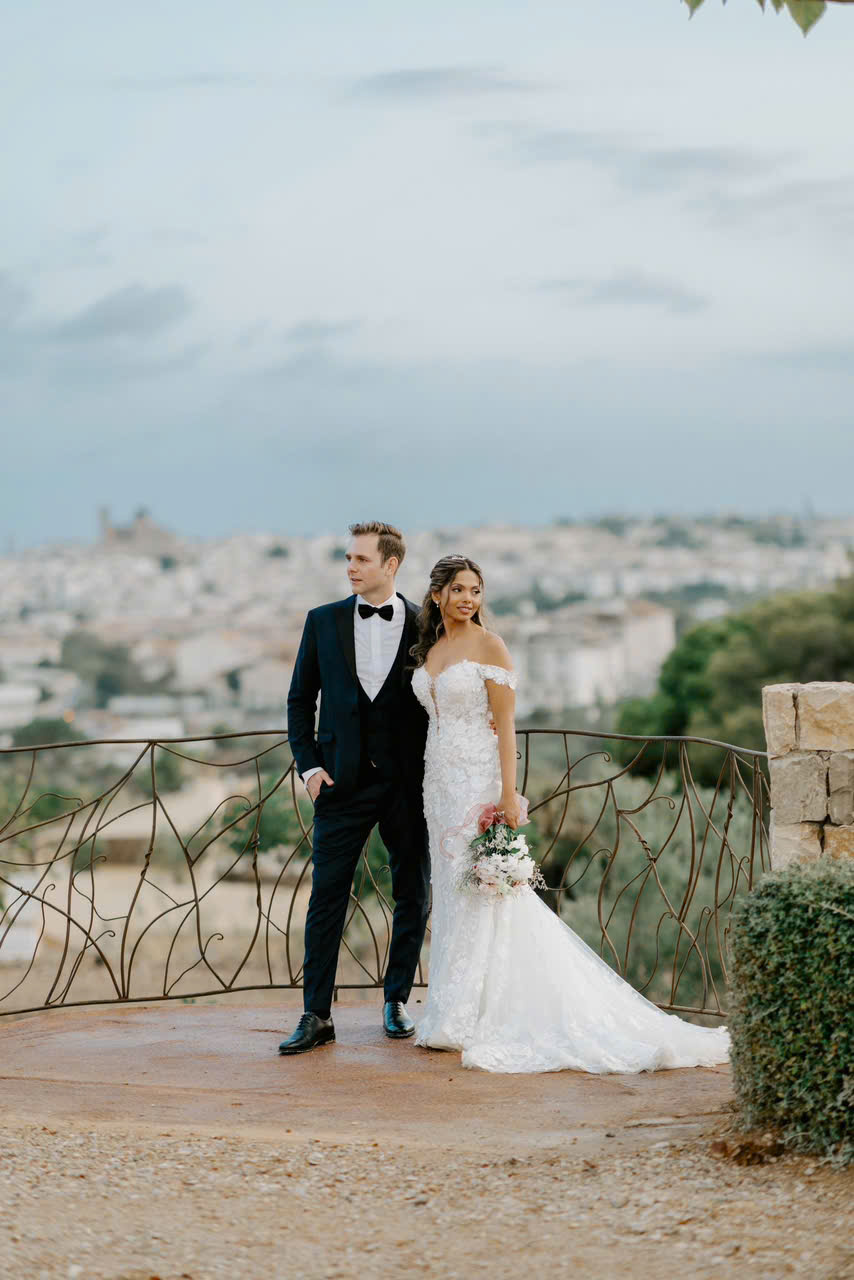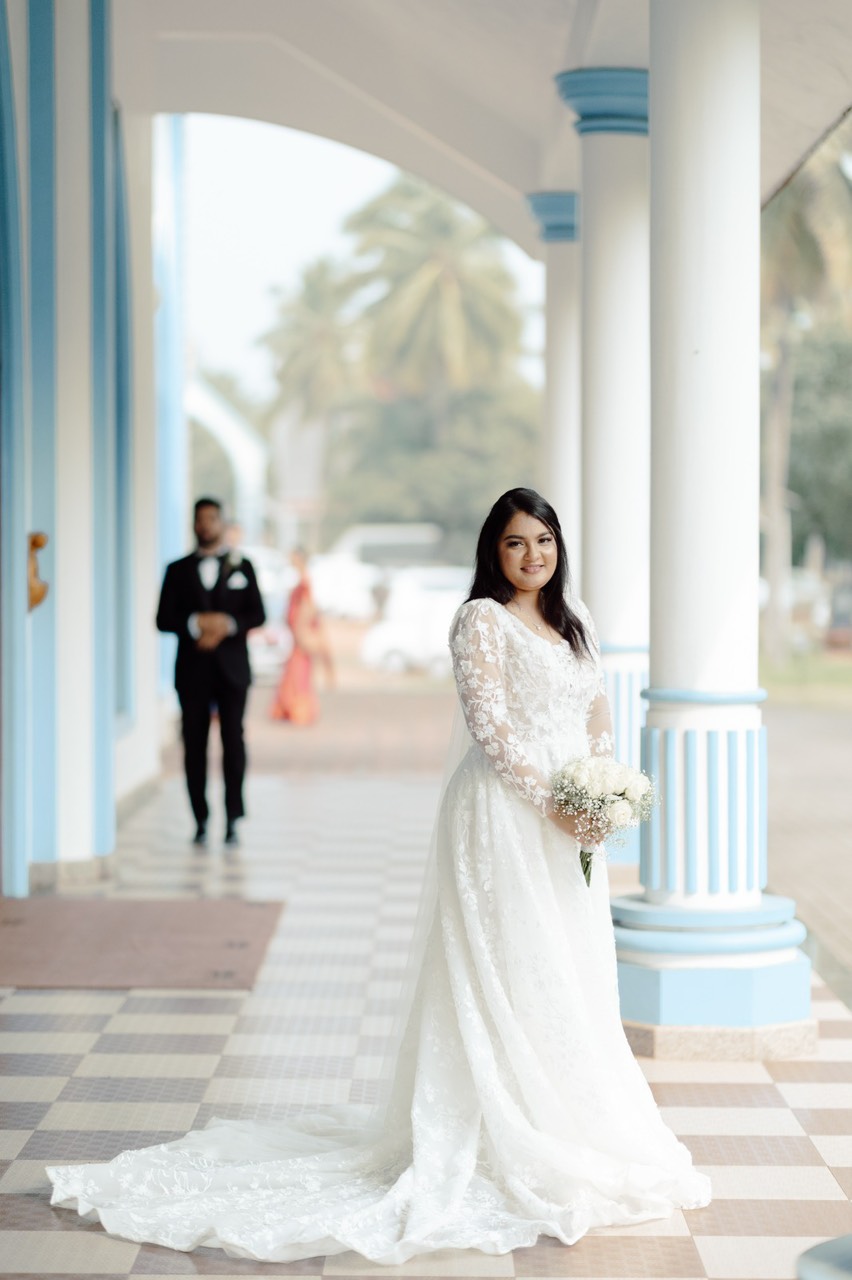Those who are planning a wedding to incorporate Vietnamese traditional wedding should be aware of the following: Though there are some “must-do’s,” it is equally critical to find a solution that satisfies the needs of both families.
It was challenging to coordinate your wedding with the bride’s family, but we are eternally grateful that they all pulled together to make our big day perfect.

We felt it was crucial to honour our parents’ heritage by following these traditional Vietnamese wedding rituals, even if they may seem archaic or quaint to some. We wished to pay tribute to them, our heritage, and our forefathers.
Picking a Lucky Date
Your mother tried to set us up on a lucky date before we did anything else. To get a marriage off to a good start in Vietnamese culture, a meaningful and fortunate date is essential.
The couple’s desired wedding season, zodiac signs, and their birth dates are among the factors considered.
Curiously, mom once remarked that our wedding date in April 2024 —would be a fortunate charm!
Not only did my mom know some individuals who might set her up with a date, but a number of them also went to a nearby temple.
An engagement party, also known as Dam Hoi
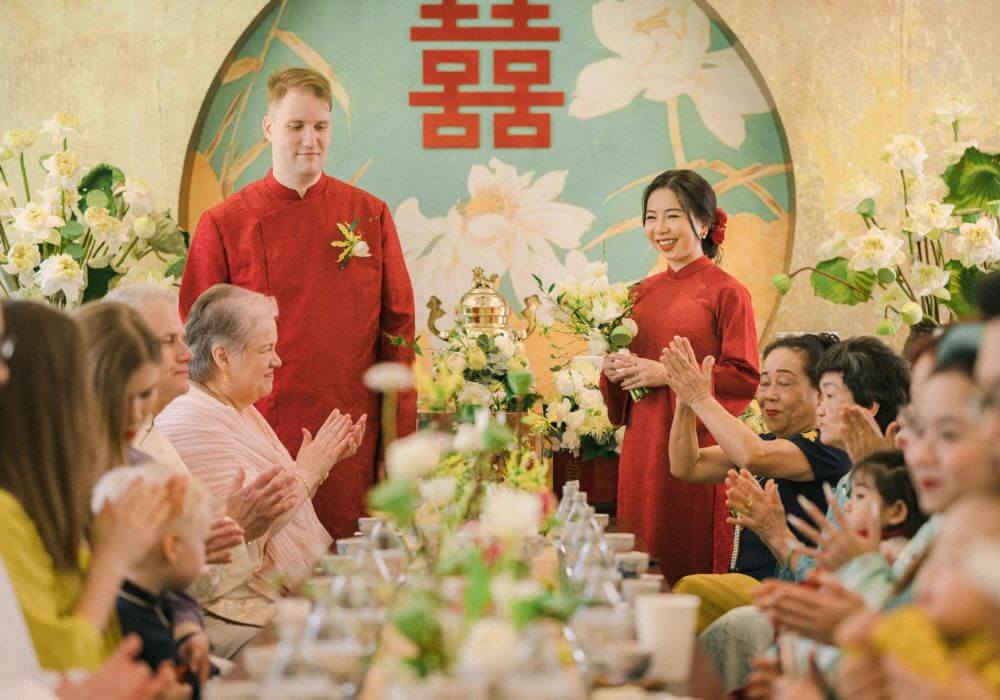
There are certain similarities between a real wedding and the Dam Hoi.
Although it will take place before the wedding, the cultural components are nearly the same.
The groom’s family will propose marriage by presenting the bride’s family with gifts.
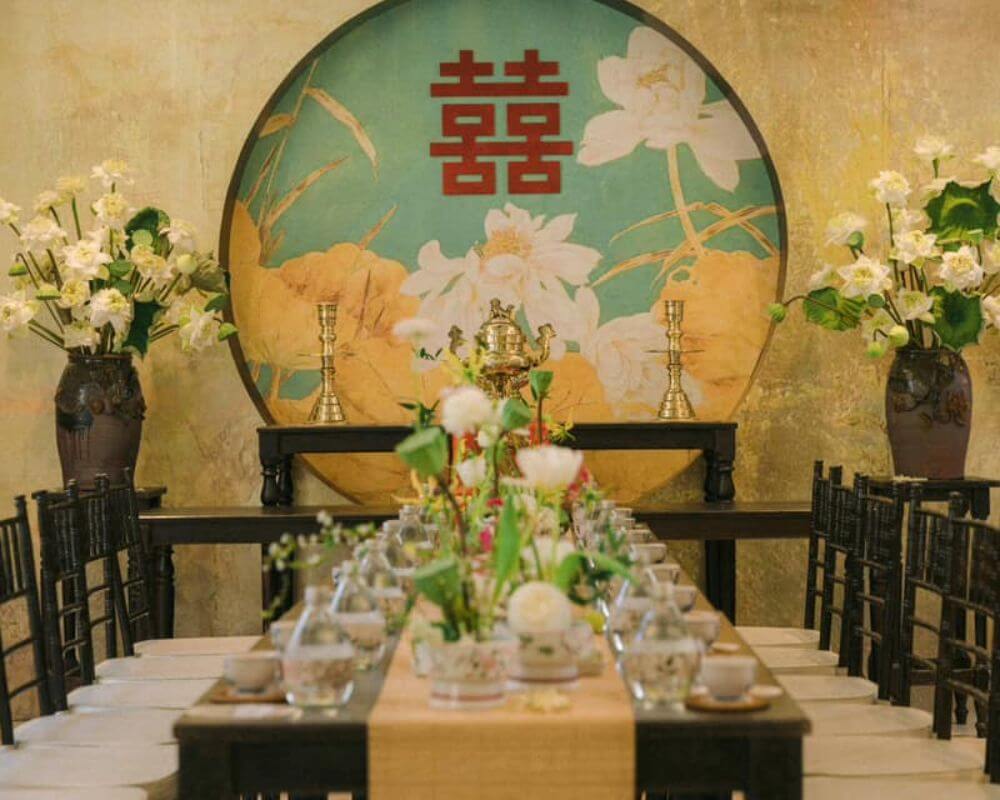
Additionally, it’s a great opportunity for relatives from both branches of the family to meet one another.
In this blog article, you may find detailed information on our Dam Hoi, the responsibilities of both families, and the procedure.
“Le Ruoc Dau,” the wedding processional
We scheduled our traditional Buddhist ceremony, Le Ruoc Dau, rehearsal, and rehearsal dinner for Fridays to avoid any unnecessary rushing.
On Saturday, we held a modern Buddhist ceremony and reception, which everyone could attend.
Everything would normally happen on the same day, but now that we’re mixing in some American wedding traditions, it can go on.
Given the early hour of the ceremony (we began at 10 a.m.!), my father brought all the mamqua along with the presents for my parents the night before.
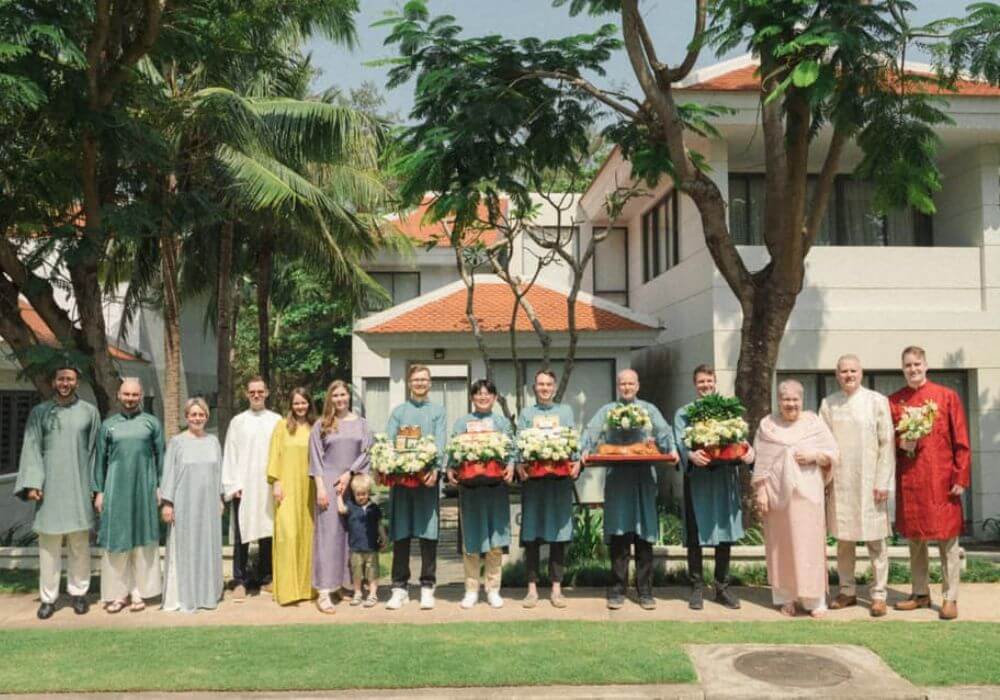
We used our Dam Hoi’s golden platters, embellished with pearls and lace. Moon cakes, pandan rice cakes, money, wine, sticky rice, and a fruit display were among the trays that my family had prepared for my visit.
We chose not to include a full-roasted pig, even though it is conventional, because our families are Buddhist.
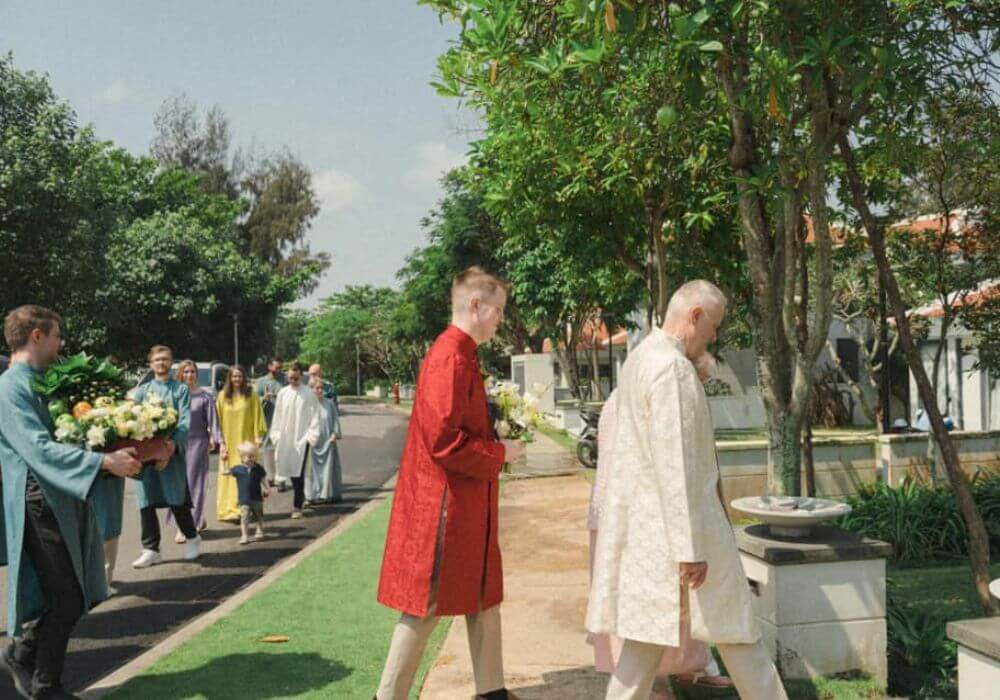
The bride’s parents will lead the procession, followed by the groom, who will hold a bouquet and a gift for the bride, his groomsmen, and any other relatives.
Because of the limited space at my parents’ house, we decided to have only direct family members attend our tea ceremony.
The processional typically starts at the groom’s house and ends at the bride’s parents’ house. Since our houses are so close, the bridesmaids and I got ready in my parents’ (the bride’s side) house, while the entire groom’s family got ready at ours!
My family and the bridesmaids were prepared to meet the groom’s side outdoors, just like the Dam Hoi.
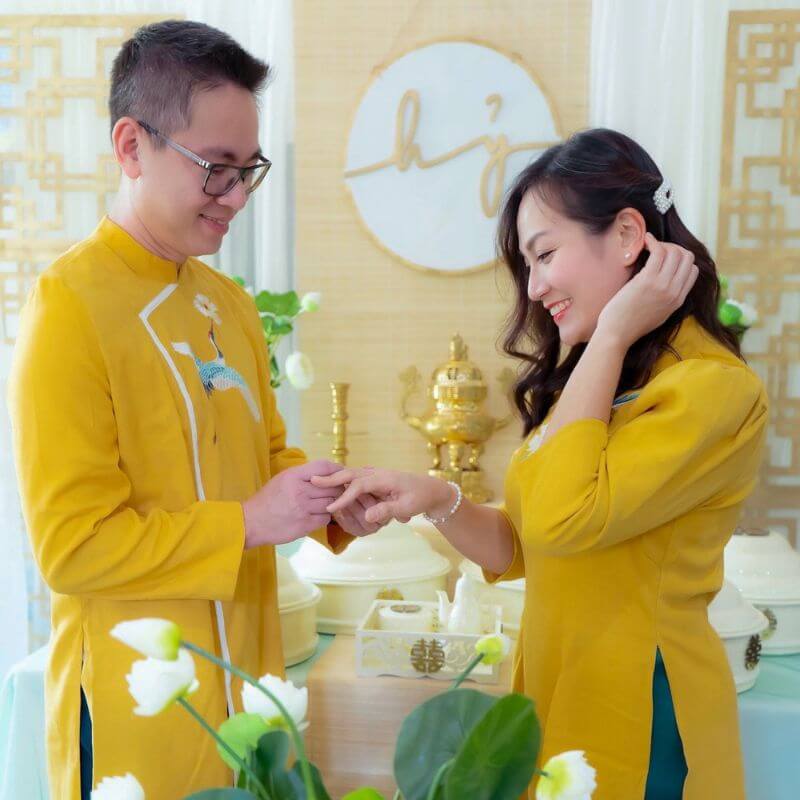
In order to set the date for to marry me, his father welcomed my parents and said that he had brought these presents for them.
Following this, the guys presented their trays to the bridesmaids. The bride’s parents will now officially welcome the groom’s family to their home.
The bridesmaids carry the trays that are placed on or near the altar. After everyone has gathered inside, the bride’s family member—often the father—will give a brief toast.
My mom did the right thing by accepting the marriage, gifts, and position as head of the household.
Father will greet the bride with cheers as she enters the chamber, and the groom will follow suit, offering her a bouquet of flowers and possibly some jewellery.
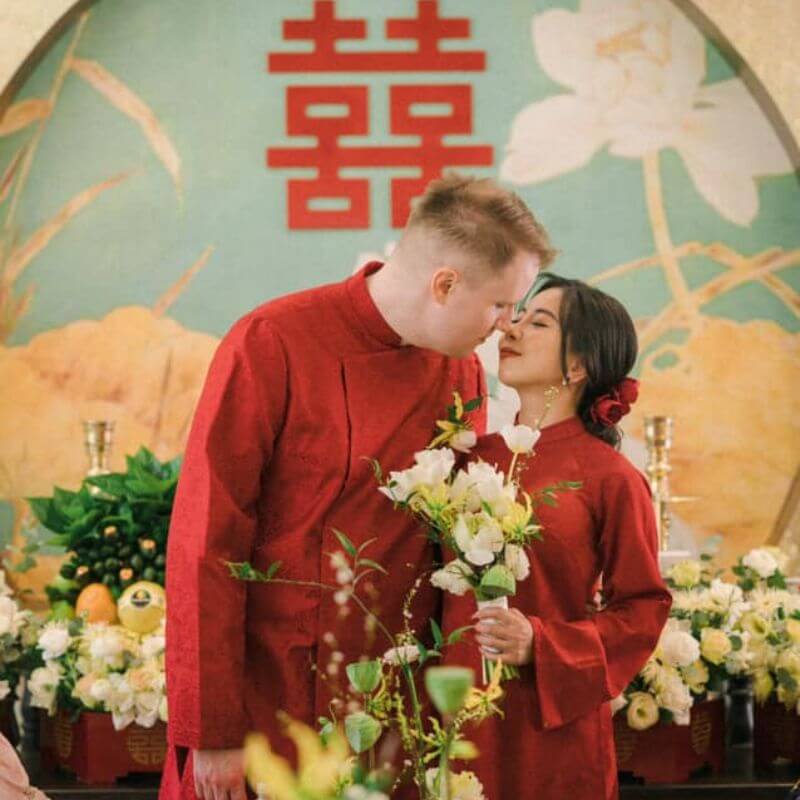
During this time, we also presented me with a wedding band.
Prays and requests at the altar.
The reception can proceed after all guests have made it inside. Here, members of the couple’s families will gather around the altar to pray and beg for the couple’s blessings.
Because family lineage and ancestors are of utmost importance in Vietnamese Traditional Wedding , it is essential to ask for their blessings throughout this wedding custom.
We included a few brief Buddhist prayers because we are Buddhists. There was no need for anything too lengthy because we were going to the temple soon. We then offered our parents tea as part of the ritual.
Submission to Parents
Vietnamese Traditional Wedding the significance of one’s parents is paramount. Their efforts to bring you up, shape you, nourish you, and prepare you for life’s challenges are selfless and monumental.
The song “Nghĩa Sinh Thành” is an old Vietnamese classic. “Gratitude for the grace of parents” is the literal translation. Almost every Vietnamese child has heard the last line of the song:Remember the source of the water you drink—that’s what the English lyrics state.
Remember filial piety when you are a child. Thai Son Mountain is the pinnacle of a father’s endeavor. Like water that never runs dry, a mother’s love and significance are boundless.
It is customary for a married couple to honour their parents and in-laws as they begin the next chapter of their lives together. Vietnamese society simply refers to parents as “Mom and Dad”; the concept of “in-laws” is non-existent. We show our appreciation for their love, work, and sacrifice.
Presents and the Red Present Packet (Li Xi)
This is the perfect opportunity to present the newlyweds with any gifts that anyone in the family may have. During the celebration, guests of a Vietnamese wedding expect to present the newlyweds with a Li Xi, also known as a red envelope.
The two-part red envelope is a significant cultural symbol in Asian marriages.
The primary goal is to ensure that the newlyweds have a prosperous and trouble-free start to their married life.
In most cases, the couple plans to purchase a home or begin trying for a family in the near future, so the money will help them get a head start financially.
After adding up their red envelopes, it is not uncommon for couples to receive a sum in the five digits.
The second is to ensure that the newlyweds don’t go into debt by covering the cost of your “meal” at the ceremony.
If you want to be a part of the Red Envelope tradition, follow these protocol rules: use fresh currency or a check, and write your name on the envelope so the happy couple knows who gave them the present!
Optimal Colour Schemes and Décor
The use of vibrant red and golden hues is a staple of Vietnamese wedding traditions.
Why? They are the fortunate colours. A lot of the decorations, including the bride’s dress, will be in red and yellow.
Vibrant flowers are another common choice. On Friday, we went for vibrant, lively colours since we knew our wedding on Saturday would be more subdued.
A sign reading “Le Vu Quy” outside the bride’s parents’ house is one of the important decorative elements.
Our previous Dam Hoi, who cited Le Dinh Hon, asserted a distinctly different perspective.
A seller on Etsy who could create the sign with Vietnamese accents was a lifesaver! I have included more links to decor suppliers in my Dam Hoi article.
Conventional Dress
Wearing traditional Vietnamese clothing is one of Vietnam’s most important wedding customs.
At the wedding ceremony, which will take place at the bride’s parents’ house, a temple, a church, or another location, the bride and groom will each wear one.
We each acquired a new costume because we decided to have two separate ceremonies spread out over two days.
A few months before our wedding, we began the process of having all four of them crafted to order by Nicole Bridal shop in Vietnam.
See more of our wedding collection here.
The bride and groom typically don red and blue, respectively, for the wedding.
The thought of wearing this to our Buddhist temple ceremony made me happy, though, because yellow is my favorite color, and I had already planned to wear it there. To match, I went for a jacquard in emerald green.
Nicole Bridal Ho Chi Minh City
- Address: 23 Street 11, Ward 7, Phu Nhuan Distric, TPHCM
- Hotline: 0902.640.490
- Fanpage: Nicole Bridal HCM
- Email: nicole.weddingbridal@gmail.com
Nicole Bridal Hanoi
- Address: 2nd Floor, No. 1 Trung Phung, Dong Da District, Hanoi
- Hotline: 0984615350
- Fanpage: Nicole Bridal Hanoi
- Email: nicolebridalhanoi@gmail.com
Opening hours Monday – Sunday: 09:00 – 21:00
Website: https://nicolebridal.vn/


